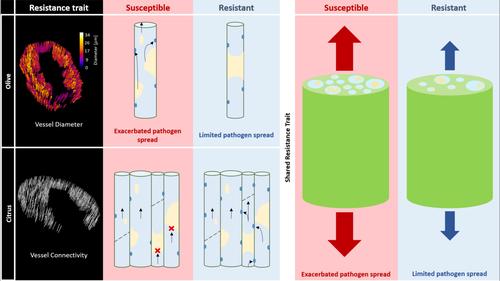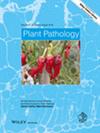对苛养木杆菌抗性和易感的橄榄和柑橘茎秆的高分辨率x射线CT图像的高通量分析
IF 2.4
3区 农林科学
Q1 AGRONOMY
引用次数: 0
摘要
细菌性植物病原体苛养木杆菌在几种全球重要作物中引起疾病。然而,一些品种的细菌负荷减少,表现出很少的症状。考虑到植物物种的分离,木质部结构影响了栽培品种对苛养x的敏感性。我们更广泛地验证了这一理论,分析了来自两个分类类群的健康和受感染植物脉管系统的高分辨率同步x射线计算机断层扫描,这些类群含有易感和抗性品种:两个柑橘品种(甜橙cv;Pera, tangor cv。Murcott)和两个橄榄品种(Koroneiki, Leccino)。结果发现,易感植株比抗性植株有更多的导管,从而促进了病原菌在宿主内的传播。然而,柑橘和橄榄不具有与抗性相关的特征。抗性柑橘茎的木质部导管与易感植物的管径相当,而抗性橄榄的管径更窄,可以限制生物膜的传播。虽然没有检测到橄榄树品种之间的差异,但结果表明,与易感柑橘植物相比,抗性柑橘植物的维管连通性更强。我们假设这为在感染下维持水力功能提供了替代的流动路径。总之,这项工作阐明了两个分类类群之间不同的生理抗性机制,同时支持了一种可以加快候选抗性植物鉴定的分类间度量的存在。本文章由计算机程序翻译,如有差异,请以英文原文为准。

A high-throughput analysis of high-resolution X-ray CT images of stems of olive and citrus plants resistant and susceptible to Xylella fastidiosa
The bacterial plant pathogen Xylella fastidiosa causes disease in several globally important crops. However, some cultivars harbour reduced bacterial loads and express few symptoms. Evidence considering plant species in isolation suggests xylem structure influences cultivar susceptibility to X. fastidiosa. We test this theory more broadly by analysing high-resolution synchrotron X-ray computed tomography of healthy and infected plant vasculature from two taxonomic groups containing susceptible and resistant varieties: two citrus cultivars (sweet orange cv. Pera, tangor cv. Murcott) and two olive cultivars (Koroneiki, Leccino). Results found the susceptible plants had more vessels than resistant ones, which could promote within-host pathogen spread. However, features associated with resistance were not shared by citrus and olive. While xylem vessels in resistant citrus stems had comparable diameters to those in susceptible plants, resistant olives had narrower vessels that could limit biofilm spread. And while differences among olive cultivars were not detected, results suggest greater vascular connectivity in resistant compared to susceptible citrus plants. We hypothesize that this provides alternate flow paths for sustaining hydraulic functionality under infection. In summary, this work elucidates different physiological resistance mechanisms between two taxonomic groups, while supporting the existence of an intertaxonomical metric that could speed up the identification of candidate-resistant plants.
求助全文
通过发布文献求助,成功后即可免费获取论文全文。
去求助
来源期刊

Plant Pathology
生物-农艺学
CiteScore
5.60
自引率
7.40%
发文量
147
审稿时长
3 months
期刊介绍:
This international journal, owned and edited by the British Society for Plant Pathology, covers all aspects of plant pathology and reaches subscribers in 80 countries. Top quality original research papers and critical reviews from around the world cover: diseases of temperate and tropical plants caused by fungi, bacteria, viruses, phytoplasmas and nematodes; physiological, biochemical, molecular, ecological, genetic and economic aspects of plant pathology; disease epidemiology and modelling; disease appraisal and crop loss assessment; and plant disease control and disease-related crop management.
 求助内容:
求助内容: 应助结果提醒方式:
应助结果提醒方式:


